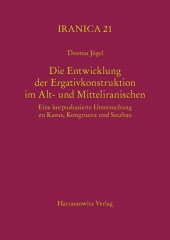 Schmitt, Rüdiger. 2014. Wörterbuch der Altpersischen Königsinschriften. Wiesbaden: Reichert.
Schmitt, Rüdiger. 2014. Wörterbuch der Altpersischen Königsinschriften. Wiesbaden: Reichert.
The present volume is closing a gap of the specialist literature felt for some time, because the glossaries and dictionaries available cover the Old Persian vocabulary only in part and are defective in some respects. For preparing a new Old Persian dictionary the situation is quite favourable at present, since a complete edition of the royal inscriptions has been published in 2009 by the author in his book “Die altpersischen Inschriften der Achaimeniden” (Wiesbaden 2009), where only some texts of minor relevance, the inscriptions on vessels, seals (and sealings) and weights, had been ignored. A dictionary like the present comprehensive work probably never had been tackled before for a corpus language like Old Persian, for in order to cope the divergent needs of all sorts of users it contains six separate lists or indexes: lists of (1) the transliterated and (2) the transcriptional word-forms (this one giving a short grammatical definition and a list of all references), (3) the lexicon proper, arranged by word-stems, roots etc. and giving a translation as well as short information about the (syntactical, phraseological or other) use of the word and its etymology, and finally (4–5) reverse indexes of the first two lists and (6) of the dictionary itself (verbal roots, nominal and pronominal stems and indeclinable words being kept apart).
For more information see the ToC and read the Preface (in German) to this volume .
About the Author:
Rüdiger Schmitt, from 1979 to his retirement in 2004 Professor of Comparative Indo-European Philology and Indo-Iranian Studies at Saarland University in Saarbrücken; born in Würzburg on June 1, 1939; studies from 1958 to 1965 in Würzburg, Erlangen and Saarbrücken, particularly with Manfred Mayrhofer; after publications on Indo-European poetical language, on the Greek and Armenian languages specialized on the ancient Iranian languages, Old Persian epigraphy and, above all, Iranian personal names.
 The second issue of the Estudios Iranios y Turanios, which was launched last year by the Sociedad de Estudios Iranios y Turanios, has been published. This issue of the journal, entitled Homenaje a Éric Pirart en su 65º aniversario, collects a number of philological discussions in honour of Éric Pirart’s 65th birthday.
The second issue of the Estudios Iranios y Turanios, which was launched last year by the Sociedad de Estudios Iranios y Turanios, has been published. This issue of the journal, entitled Homenaje a Éric Pirart en su 65º aniversario, collects a number of philological discussions in honour of Éric Pirart’s 65th birthday.
 Jügel, Thomas. 2015.
Jügel, Thomas. 2015.  Hassandust, Mohammad. 2015. The etymological dictionary of Persian. 5 Vols. Tehran: Academy of Persian Language and Literature.
Hassandust, Mohammad. 2015. The etymological dictionary of Persian. 5 Vols. Tehran: Academy of Persian Language and Literature. Schmitt, Rüdiger. 2014.
Schmitt, Rüdiger. 2014.  Talattof, Kamran. 2015.
Talattof, Kamran. 2015.  Haw, Stephen. 2014.
Haw, Stephen. 2014.  Gzella, Holger. 2015.
Gzella, Holger. 2015.